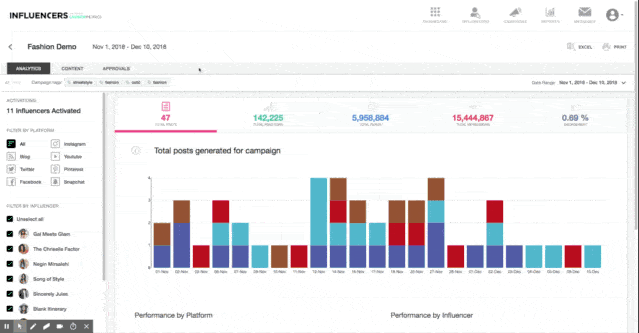“Influence” is a wide concept that has passed through many iterations over the last decade and, since the dawn of influencer marketing, ‘the influencer’ has become a billion-dollar business. In today’s marketing climate, it is necessary to understand the different types of influencers according to their followers and objectives, which brands in the fashion, luxury and cosmetics sectors can utilize in their campaigns.
According to our recent State of Influencer Marketing 2019 report, 45.5% of industry professionals believe that the so-called “Micro Influencers” (the tier of opinion leaders that command smaller communities) are the most effective in reaching their target audience. On the other hand, there are cases in which larger influencers are favored and their audiences are leveraged to deliver a much faster and wider-reaching impact for brands. Actions with this tier of influencer help create mass awareness or increase the sales of an exclusive product.
So, the question is: what types of influencers are there and what kind of impact can you expect from them? In this article, we bring together the four tiers of influencers that exist and analyze the brand campaigns that have achieved the required effect thanks to their type of the influence.
In this article you’ll learn…
Micro Influencers (10K – 100K)
As mentioned previously, these types of influencers are the opinion leaders with audiences of around 10,000 – 100,000 followers and is one of the most sought after of late. According to 32% of professionals in the fashion, luxury, and beauty industries, the main reason driving this is because they believe Micro Influencers connect easily with their desired target audience.
There are several factors that indicate why, but the reality is that it’s due to the saturation of a market in which many types of influencers on social networks have practically become “advertising marquees”; One day a shoe collection is announced, the next day a car is raved about, and the next a hotel or restaurant that can’t be missed is featured. As a consequence, some brands have begun to distrust the true impact that Mega and All-Star Influencers can offer when wanting to reach a specific target audience.
An example of a successful partnership like this is that of Spanish retailer Oysho and their collaborations with Spanish Micro Influencer Olga Victoria (@dirty_closet, 100,000 followers). Thanks to the publications shared by this influencer and according to our impact analysis based on the MIV criteria, the brand managed to obtain almost €88,000 in Media Impact Value ™ (MIV®) during the first half of 2019.
Ver esta publicación en InstagramUn culo! 🤭 • #dirtycloset #bikinilife #summermood #beachwear #trikini @oysho
Main characteristics of Micro Influencers
- Audiences are highly segmented and, therefore, easily tailored.
- Strong levels of engagement rate and the ability to garner reactions from their audiences.
- Built high fidelity with the consumer.
- Offer rates and pricing that small and medium-sized brands can afford.
Mid-Tier Influencers (100K – 500K)
Mid-Tier Influencers are another collective that brands have been turning to recently – 37.7% say they prefer to work with them to achieve their objectives. They are at a point where their audience is slightly ampler, yet the communities are still targeted, easy to communicate with and engaged.
Within this group, we find influencers such as Veronica Diaz (@modajustcoco), whose Voice is so powerful that just by simply tagging brands like Zara in her publications, she drums up brand value – even if that same content also features other, related brands. The key to success when it comes to these posts is that they are generally authentic and natural-looking, and it is difficult to identify whether it is an organic action, or a paid one. According to our data analysis, this opinion leader generated 1.9 million euros in Media Impact Value for Zara.
Ver esta publicación en InstagramTal para cual 🖤 @missgalacoqueta #MamiyGala #JustCoco Abrigos – @zara Botas – @ponysonline @ugg
Main characteristics of Mid-Tier Influencers
- Still create content for segmented audiences that are easy to reach and engage.
- Maintain a certain level of exclusivity within a wider audience as multi-brand collaborations are low in number.
- Working with several Mid-Tier Influencers offers the possibility to amplify your campaign’s impact on loyal followers.
- Their rates and costs allow small and medium businesses to leverage their influence.
Mega Influencers (500K – 2M)
Now we address a category of influencers that come with a high price tag per campaign and publication, but also a guarantee that they’ll reach extremely large numbers of social media consumers. These are well-known personalities who generally collaborate with several brands at the same time. With Mega Influencers, it is essential to sign collaboration agreements that guarantee limited exclusivity during the campaign period or, at least, request that the influencer doesn’t use the brand in the same publications as competitors during the said period.
According to The State of Influencer Marketing 2019 report, 5.3% of professionals in the fashion, luxury and cosmetics industries find the creation of legal agreements a challenge when collaborating with influencers. Though not a very high percentage, these agreements are important to ensure that investments made in this tier of influencer obtain the best results and return, avoiding any potential failure or error.
The influencer Maria Pombo sits perfectly within this group, and her collection with Lefties is the perfect example of the type of actions worth developing with Mega Influencers to fully take advantage of their reach. The Inditex Group decided to launch a Maria Pombo-inspired collection this year, for which they used the branded hashtag #selectedbymariapombo. Thanks to this collaboration, Lefties obtained a MIV of almost one million euros (€ 944.7K), and that’s just during the first half of 2019.
Ver esta publicación en Instagram
Main characteristics of Mega Influencers
- Large audience with various communities.
- Offer the possibility to increase the reach of your brand quickly.
- Contribute to the growth of sales during product campaigns.
- They have a relatively high cost, depending on their profile.
All-Star Influencers (+ 2M)
And finally, the coveted All-Star Influencers. These are opinion leaders that are often mistaken for celebrities due to the sheer number of followers they possess, but it’s their exclusive dedication to generating digital content that sets them apart. Chiara Ferragni, also known by her alias The Blonde Salad, is a prime example of an All-Star Influencer, and one that boasts an audience of more than 2 million.
Ver esta publicación en Instagram
The greatest risk that these influencers present is their pricing for partnerships, and that their impact is highly mixed since their activity over the years with numerous brands has generated very large and varied audiences. This means that you will probably achieve a rapid and massive impact through collaborating with them, but it’s hard to identify the quality of the audience reached with respect to your brand or the guarantee of consumer activation. It’s worth noting, that engagement rates with these influencers are generally reduced.
Main characteristics of the All-Star Influencers
- Command massive followings consisting of highly diverse audiences (it is difficult to identify a specific segment within them).
- Immediate impact and high reach are guaranteed.
- They are confused with ‘celebrities’ and the user is less loyal.
- Their pricing limits their accessibility to large brands.
Understand the return offered by each type of influence based on the data
As you have seen, choosing the optimal tier of influencer for your brand depends on various factors: budget, length of collaboration, objectives, profile (which is similar to your brand values), etc. These could be isolated one-off actions or distributed throughout the year, working on various campaigns and actions aimed at different objectives.
Therefore, it is essential to use data to identify which influencer profiles offered you the highest return on investment (ROI) in order to optimize your strategy for the following year. A dashboard like this can help you visualize this information, as well as understand the type of content that had the best performance for each type of influencer.
![]()
Do you want to learn more about the selection and management of Influencer campaigns? Download our Influencer 101 Guide.


